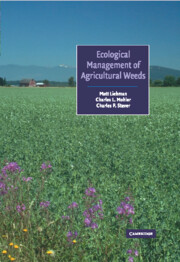Book contents
- Frontmatter
- Contents
- Preface
- 1 Weed management: a need for ecological approaches
- 2 Weed life history: identifying vulnerabilities
- 3 Knowledge, science, and practice in ecological weed management: farmer–extensionist–scientist interactions
- 4 Mechanical management of weeds
- 5 Weeds and the soil environment
- 6 Enhancing the competitive ability of crops
- 7 Crop diversification for weed management
- 8 Managing weeds with insects and pathogens
- 9 Livestock grazing for weed management
- 10 Weed evolution and community structure
- 11 Weed management: the broader context
- Taxonomic index
- Subject index
9 - Livestock grazing for weed management
Published online by Cambridge University Press: 10 November 2009
- Frontmatter
- Contents
- Preface
- 1 Weed management: a need for ecological approaches
- 2 Weed life history: identifying vulnerabilities
- 3 Knowledge, science, and practice in ecological weed management: farmer–extensionist–scientist interactions
- 4 Mechanical management of weeds
- 5 Weeds and the soil environment
- 6 Enhancing the competitive ability of crops
- 7 Crop diversification for weed management
- 8 Managing weeds with insects and pathogens
- 9 Livestock grazing for weed management
- 10 Weed evolution and community structure
- 11 Weed management: the broader context
- Taxonomic index
- Subject index
Summary
Introduction
Cattle, sheep, goats, and other domesticated vertebrates graze more than 50% of the earth's total land area, 20% in managed pastures and 30% in rangelands (Snaydon, 1981). Animal production and cropland management are also frequently linked. Animals graze the herbaceous understory in tree crops and feed on residues and remnant vegetation in annual crop fields. Animal manures are applied to croplands, and pastures and forage crops are rotated with annual crops.
Domesticated herbivores can accentuate weed problems for humans. They disperse weed seeds (Chapter 2). They graze preferred species heavily, but leave unpalatable species to grow and reproduce. They compact soil around watering holes, at resting sites, and along trails, which fosters grazing- and trampling-tolerant unpalatable weedy vegetation. Introduced forage species naturalize to become weedy invaders (Low, 1997).
However, through managed grazing animals can also reduce weedy vegetation and promote desirable forage species. This chapter illustrates three principles for the use of livestock to reduce weeds in annual and perennial crops and on grazing lands:
A weed's susceptibility to control by grazing depends on its growth habit, its life cycle stage and the growing conditions at the time of grazing, and its palatability to different herbivore species. The identification of a weed's particular vulnerabilities to grazing contributes to understanding why it has become a problem or might become a problem. Whether a weed is vulnerable to control by grazing also depends on the other plant species in the same grazed area and their ability to tolerate and avoid grazing. In fact, a weed in one context may be a primary forage species in another.
[…]
- Type
- Chapter
- Information
- Ecological Management of Agricultural Weeds , pp. 409 - 443Publisher: Cambridge University PressPrint publication year: 2001
- 1
- Cited by



